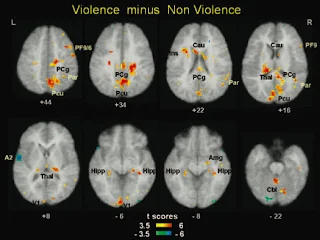It is true that animal and human brains have a ‘limbic center’ that makes it possible for us to experience fear and anger, among other feelings that are important for our survival. However, a normal person’s brain does not generate these emotions on its own, but rather in response to external stimuli and their interpretation as threats.
The limbic center is surrounded by regions of the brain whose function is to moderate, control, channel, and limit the expressions of that fear and anger. They help us interpret a situation’s threat level and decide how to respond in order to protect ourselves from danger.
Using these functions, we can purposefully stimulate the limbic center and intensify our feelings of fear or anger in preparation to respond, or use those same functions to voluntarily calm ourselves and tranquilize our bodies. Education and training have a powerful influence on the way we handle this. In the Seville Statement on Violence we read:
It is scientifically incorrect to say that humans have a ‘violent brain’. While we do have the neural apparatus to act violently, it is not automatically activated by internal or external stimuli. Like higher primates and unlike other animals, our higher neural processes filter such stimuli before they can be acted upon… There is nothing in our neurophysiology that compels us to react violently.It is also true that focused brain damage and other mental diseases can make it hard for us to control our feelings of fear and anger. by altering their intensity in the limbic center and/or obstructing the moderating functions of the other parts of the brain. They often cause attacks that are similar to certain types of epilepsy, whose victims can lose not only their control but also their memory.
These ailments can be caused by extreme malnutrition, the use of certain drugs, blows to the head, etc., and tend to be intensified by the use of alcohol and other external stimuli. However, one cannot define the nature of the entire human race by the pathologies of a small percentage of the population. Just as the normal state of the human body is not determined by a small percentage of broken bones, we cannot define human nature by a small proportion of damages to the brain and mental illnesses.
Some studies have taken the opposite tack and suggested that human beings have a ‘peaceful brain’. For example, there is one center that controls our artistic and holistic abilities, another one that gives us feelings of peace and happiness, and in the frontal cerebellum they have even found what seems to be the center that enables us to have the mystical experience of the presence of God.
To which of these two extremes should we give credence? The violent brain or the peaceful brain? It is as if one study stated that your head turns left, and another that it turns to the right, and you were asked to determine which was correct. Both, of course! Human brains provide us with the entire range of sensations, feelings and emotions that make up the breadth and depth of the human experience. We are the ones who choose which to give importance in our lives and how to act in response to them.
For further information on this topic by the same author, click here.


No comments:
Post a Comment